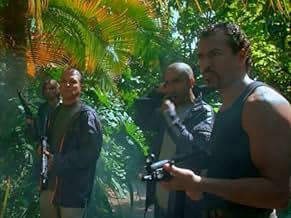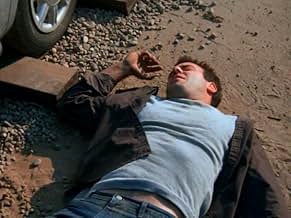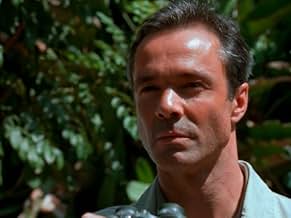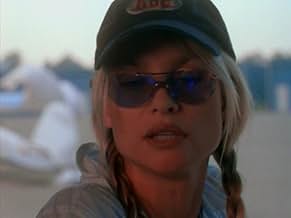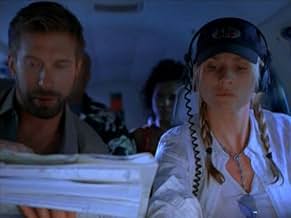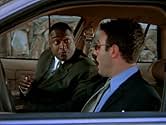A cop finds a mysterious map from the Age of Exploration inside a stolen painting, and enlists the aid of his antiquarian brother to solve its riddles .A cop finds a mysterious map from the Age of Exploration inside a stolen painting, and enlists the aid of his antiquarian brother to solve its riddles .A cop finds a mysterious map from the Age of Exploration inside a stolen painting, and enlists the aid of his antiquarian brother to solve its riddles .
William Langlois
- Manny
- (as William Langlois Monroe)
Rene Raymond Rivera
- Eduardo
- (as René Rivera)
Joey Sagal
- Chuck "Chucky" Daniels
- (as Joe Sagal)
GiGi Erneta
- Girl on Phone
- (as a different name)
Featured reviews
The writing was puerile and run of the mill, the director should have flogged. But Steven Baldwin was understated and came across very naturally - there's that.
It's gotta be fascinating to find out how movies like this get made. The budget and ambition of the film-makers appear to be large enough for pyrotechnics and CGI effects, with perhaps stock-footage accounting for some big-ticket items such as a fairly unnecessary scene inside a naval ship.
But let's start with that title. "Lost Treasure." Sure, that's what the movie is about, but could you have a more mundane title? That's like, say, calling "Independence Day" "Attack By Aliens." As noted by other reviewers, almost everything about this film is subpar, and yet it is still somewhat watchable. About the only reason for this is Mark Christopher Lawrence adding some much-needed comic relief as a disgruntled tourist. Otherwise, the only entertainment is derived from seeing how ridiculously bad the parts of the stereotypical bad guys are written. You could blame the actors, but why when they're given nothing to work with that you haven't already seen in countless other movies?
Meanwhile, on the good guy side, Coby Ryan McLaughlin tries gamely in his role of kidnapped cop, but his acting ability is the epitome of the entire movie in its averageness. Top billing goes to Stephen Baldwin, who does little more than reprise his role in the equally-awful "Shelter Island" as a brooding, moody type. About the only depth he's added to his character here is a beard.
Basically, pile some explosions, car chases and scenes of people being chased round an island in a storm on top of wooden acting and stilted dialogue and you have a very run-of-the-mill play-it-by-the-numbers movie that might not be the biggest travesty committed to celluloid, but doesn't add anything to the world of cinema either.
But let's start with that title. "Lost Treasure." Sure, that's what the movie is about, but could you have a more mundane title? That's like, say, calling "Independence Day" "Attack By Aliens." As noted by other reviewers, almost everything about this film is subpar, and yet it is still somewhat watchable. About the only reason for this is Mark Christopher Lawrence adding some much-needed comic relief as a disgruntled tourist. Otherwise, the only entertainment is derived from seeing how ridiculously bad the parts of the stereotypical bad guys are written. You could blame the actors, but why when they're given nothing to work with that you haven't already seen in countless other movies?
Meanwhile, on the good guy side, Coby Ryan McLaughlin tries gamely in his role of kidnapped cop, but his acting ability is the epitome of the entire movie in its averageness. Top billing goes to Stephen Baldwin, who does little more than reprise his role in the equally-awful "Shelter Island" as a brooding, moody type. About the only depth he's added to his character here is a beard.
Basically, pile some explosions, car chases and scenes of people being chased round an island in a storm on top of wooden acting and stilted dialogue and you have a very run-of-the-mill play-it-by-the-numbers movie that might not be the biggest travesty committed to celluloid, but doesn't add anything to the world of cinema either.
Evidently, a good place to hide a fifteenth century treasure map is behind a not very interesting painting, which will eventually end up in an art gallery. How would anyone know that it was hidden behind a painting? Well that, and most of the other details of this film, is never explained. For example, why would an art museum be loaded up with 55-gallon drums of gasoline, so that when it is torched as a diversion to stealing the painting, they could explode like rockets? And for that matter, with all the exploding and flames everywhere, the painting should have been burnt to a crisp before anyone had a chance to swipe it. But this is supposed to be a thriller, so all the absurd pyrotechnics of the beginning were evidently thought necessary to startle the twelve-year-olds in the audience.
After that as an introduction, the basic idea is that there are no good guys, just varying degrees of bad guys and bystanders, who end up chasing after a lost treasure. Never mind that one is a cop and another a government agent, sworn to an oath to serve the public, and hence any treasure they might discover as a result of doing their jobs would more correctly belong to the people they serve. In other words, the basic message of this film is that serving the public might be fine in theory, but when the potential for feathering one's nest with a vast fortune gets involved, best to take the money and run. No wonder the current generation has so little faith in public servants. When they go to the movies, they see them portrayed as only marginally less greedy than the crooks.
This is a shameful story, which promotes the view that no matter how you end up with the loot, it is yours to keep and enjoy. The bad guys, who want to keep it all for themselves, must first be knocked out of course, after which the `good' guys get to divide the hoard. And the reason why they are `different' from the crooks is because they are less `violently' motivated by greed. In other words, if avarice is pursued less violently, perhaps more humanely, then it's okay. In any case, what matters is that you end up with the prize. Having the money is more important that how you got it. That, unfortunately, is the message of this story, and it is as harmful to the fabric of society as it could possibly be. It makes greed seem romantic and exciting, while acting as though social responsibility was not even worth considering.
After that as an introduction, the basic idea is that there are no good guys, just varying degrees of bad guys and bystanders, who end up chasing after a lost treasure. Never mind that one is a cop and another a government agent, sworn to an oath to serve the public, and hence any treasure they might discover as a result of doing their jobs would more correctly belong to the people they serve. In other words, the basic message of this film is that serving the public might be fine in theory, but when the potential for feathering one's nest with a vast fortune gets involved, best to take the money and run. No wonder the current generation has so little faith in public servants. When they go to the movies, they see them portrayed as only marginally less greedy than the crooks.
This is a shameful story, which promotes the view that no matter how you end up with the loot, it is yours to keep and enjoy. The bad guys, who want to keep it all for themselves, must first be knocked out of course, after which the `good' guys get to divide the hoard. And the reason why they are `different' from the crooks is because they are less `violently' motivated by greed. In other words, if avarice is pursued less violently, perhaps more humanely, then it's okay. In any case, what matters is that you end up with the prize. Having the money is more important that how you got it. That, unfortunately, is the message of this story, and it is as harmful to the fabric of society as it could possibly be. It makes greed seem romantic and exciting, while acting as though social responsibility was not even worth considering.
I have no idea why these films are still made. "Lost Treasure" -- the over-simplified title says it all. I had no plans to see it at all... I just bumped upon it (however lame that sounds, it's true). William Baldwin with a beard is the 'star' of this film. But what can actors do when they are to play such stereotypical and two-dimensional characters? The film used archive or shelf footages for CGI effects etc. That confirms that it's a low-budget venture after all.
It has a story you have heard/seen million times before. It has actors at their worsts. It has dialogues that encourage fourth-graders to write a screenplay. Nothing in it shows any trace of innovation or originality. How many films such as these are awaiting us in the future?
It has a story you have heard/seen million times before. It has actors at their worsts. It has dialogues that encourage fourth-graders to write a screenplay. Nothing in it shows any trace of innovation or originality. How many films such as these are awaiting us in the future?
I am fascinated by this film. It has Made-For-TV all over it, but there is way too much money on the screen for that. Others here have flat-out panned this film as a waste of time and questioned how films like this get made. I would like to ask what was the context of this film's production? It certainly could not have been done for a US theatrical release with the cast used, yet the money spent on production places this WAY out of the range of an Indie filmmaker. So, this means it was either contracted for a major cable release and foreign sales. But I can't find evidence of either. If anyone knows, I would love to hear the details. There are some valuable lessons in film distribution embedded here - if only someone will take us behind the scenes!
BTW - many ripped the effects as being out of character with the story and second rate. I agree with out-of-character but there was a ton of money in some of those effects. It is almost like someone bought the negative of a major but obscure foreign production and mapped a story around some of the major scenes in the "other" film. That would explain why an art museum would have drums of gas in the basement. It would also explain how the "big stuff" got into a film with such a low budget look and cast.
BTW - many ripped the effects as being out of character with the story and second rate. I agree with out-of-character but there was a ton of money in some of those effects. It is almost like someone bought the negative of a major but obscure foreign production and mapped a story around some of the major scenes in the "other" film. That would explain why an art museum would have drums of gas in the basement. It would also explain how the "big stuff" got into a film with such a low budget look and cast.
Did you know
- TriviaThe scenes of the plane taking off, flying through a storm and crash landing on a beach were taken from 6 jours, 7 nuits (1998).
- GoofsThe plane is red over silver until the passengers are exiting after the crash, when it becomes a white plane with blue stripes.
- ConnectionsReferences L'île aux naufragés (1964)
Details
- Release date
- Country of origin
- Language
- Also known as
- Lost Treasure: Le trésor perdu
- Filming locations
- Production companies
- See more company credits at IMDbPro
- Runtime1 hour 25 minutes
- Color
Contribute to this page
Suggest an edit or add missing content


